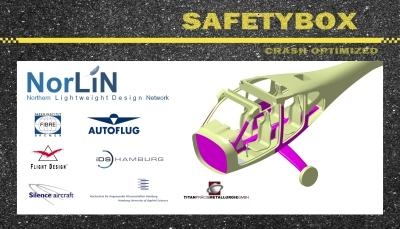Sat, Apr 12, 2014
Flight Design C4 Aircraft Is First Target Application
The German Ministry of Economic Affairs has granted funding for a research project that aims at development of a modular “SafetyBox” cabin safety system for light aircraft. The new system will provide a safety cage around the occupants of an aircraft, whose functionality builds upon an integrated consideration of several elements, namely intelligently designed and located crash absorber elements, stiff cabin structure with dedicated load paths for the majority of crash scenarios, seat installation and restraint systems. This is significantly supported by crash-optimized ergonomic designs and enhanced fire protection concepts.

The concept goes significantly beyond current aircraft designs, where the certification requirements plainly ask for consideration of certain crash accelerations to the seat and restraint system, regardless of the capability and level of energy absorption of the surrounding fuselage cell. With the new approach selected in this research program, the SafetyBox project team is optimizing the interaction of all the available elements in the early design phase of an aircraft. This will lead to a system of multiple modular elements that subsequently can be tailored to multiple applications in various aircraft designs. With this, the SafetyBox team is leading a path that is fully in line with the intentions of the current Part 23 re-write activity, jointly driven by all major Aviation Authorities, aircraft industry and aircraft users.
The SafetyBox project team has selected Flight Design’s new C4 aircraft as the first aircraft for the application of the system. Development times of the SafetyBox system match naturally with the development times of the C4 project, which makes this a natural initial project. The full development will culminate in full scale crash testing of a completed aircraft under controlled conditions, planned for Summer 2015, to validate the superior suitability of the new system. The system is designed as a modular system and will be offered to other aircraft manufacturers on the market, application is not limited to Flight Design products.
The funding has been granted by the German Ministry of Economic Affairs within the ZIM initiative and was granted through AiF as the responsible executive organization. The application activity was launched by NorLiN Northern Lightweight Design Network of Hamburg, and involves the development partners Autoflug GmbH, Flight Design GmbH, Silence Aircraft GmbH, Titan Präcis Metallurgie GmbH, HAW Hamburg – Department Fahrzeugtechnik und Flugzeugbau together with iDS Hamburg, and Faserinstitut e.V (FIBRE). The project is coordinated by Faserinstitut Bremen e.V. (FIBRE).
Flight Design presented this project with displays at AERO Friedrichshafen.
More News
A Puff Of Smoke Came Out From The Top Of The Engine Cowling Followed By A Total Loss Of Engine Power On May 9, 2025, about 1020 mountain daylight time, an experimental amateur-buil>[...]
From 2022 (YouTube Edition): Jenny, I’ve Got Your Number... Among the magnificent antique aircraft on display at EAA’s AirVenture 2022 was a 1918 Curtiss Jenny painstak>[...]
Very High Frequency (VHF) The frequency band between 30 and 300 MHz. Portions of this band, 108 to 118 MHz, are used for certain NAVAIDs; 118 to 136 MHz are used for civil air/grou>[...]
“From approximately November 2021 through January 2022, Britton-Harr, acting on behalf of AeroVanti, entered into lease-purchase agreements for five Piaggio-manufactured airc>[...]
From 2008 (YouTube Edition): US Fish and Wildlife Service Chooses The Kodiak To Monitor Waterfowl Populations Waterfowl all over North America may soon have to get used to a new ab>[...]
 NTSB Prelim: Lee Aviation LLC JA30 SuperStol
NTSB Prelim: Lee Aviation LLC JA30 SuperStol Classic Aero-TV: Curtiss Jenny Build Wows AirVenture Crowds
Classic Aero-TV: Curtiss Jenny Build Wows AirVenture Crowds ANN's Daily Aero-Term (05.30.25): Very High Frequency (VHF)
ANN's Daily Aero-Term (05.30.25): Very High Frequency (VHF) Aero-News: Quote of the Day (05.30.25)
Aero-News: Quote of the Day (05.30.25) Classic Aero-TV: Quest Kodiak Enhances Migration Monitoring Programs
Classic Aero-TV: Quest Kodiak Enhances Migration Monitoring Programs



